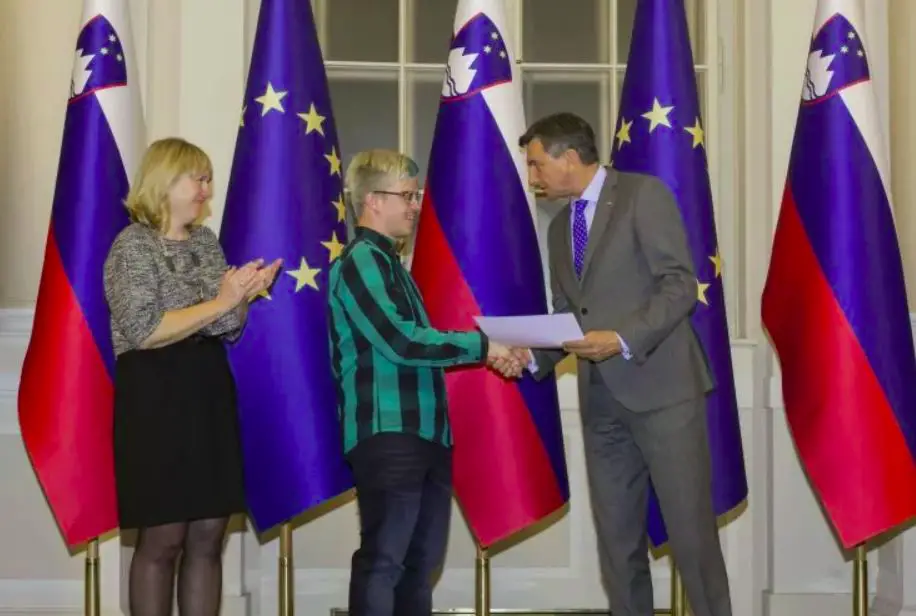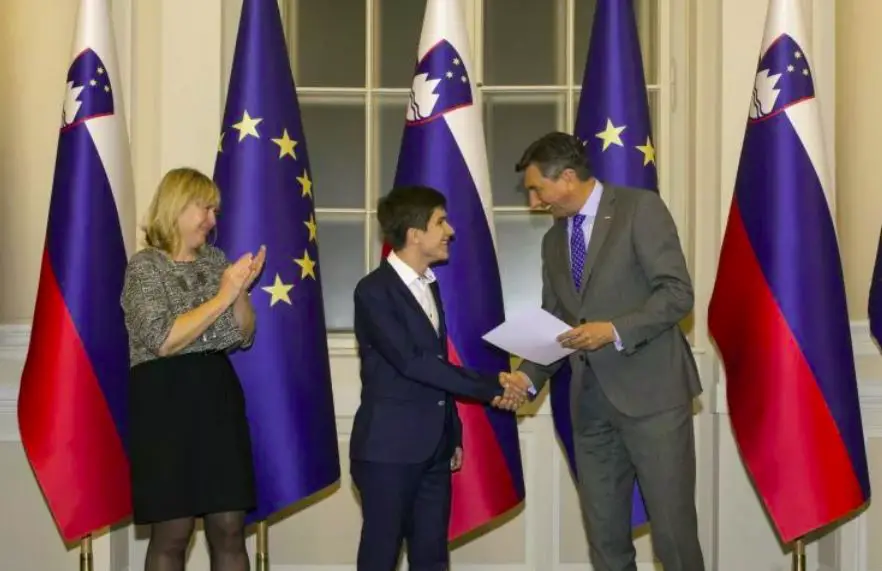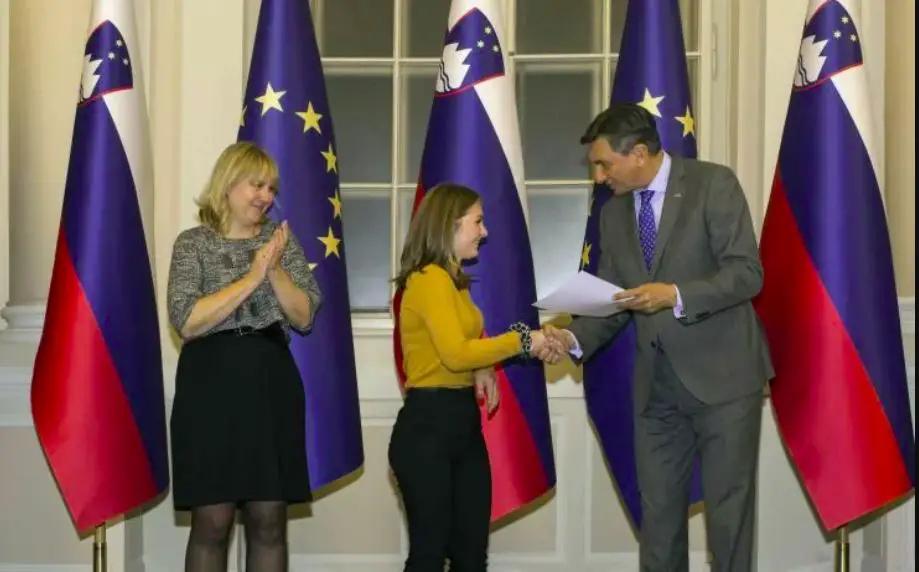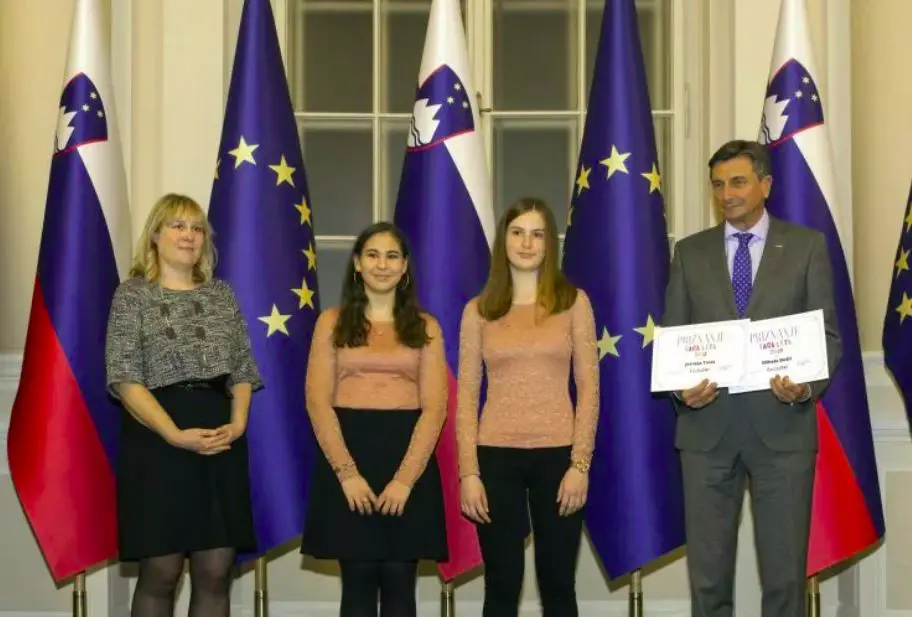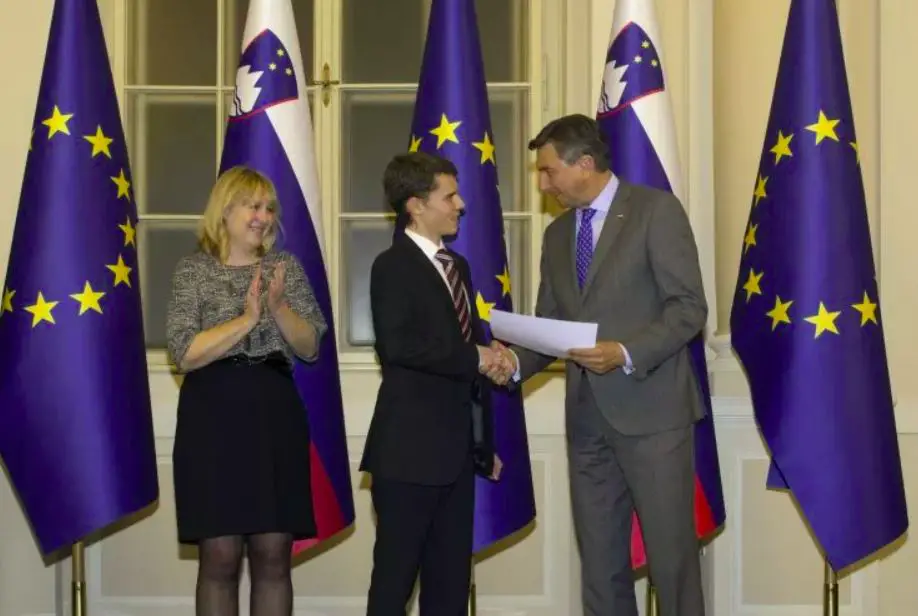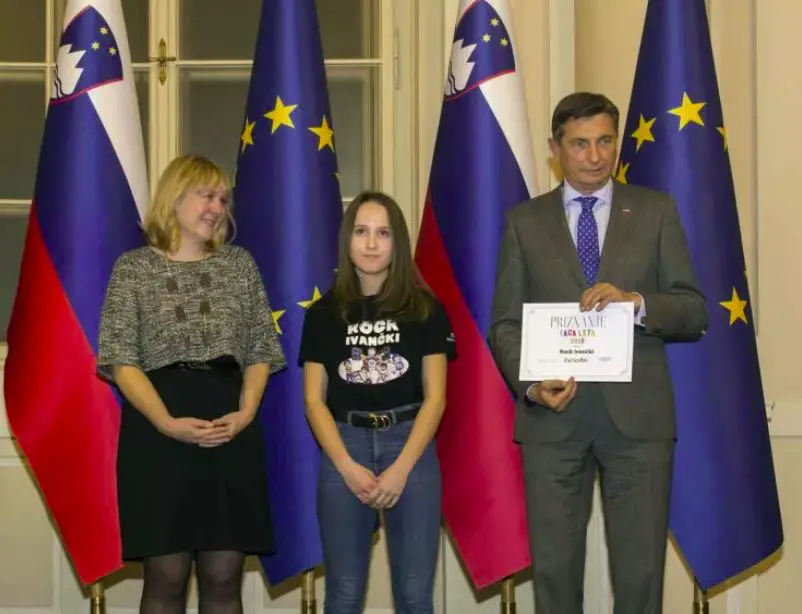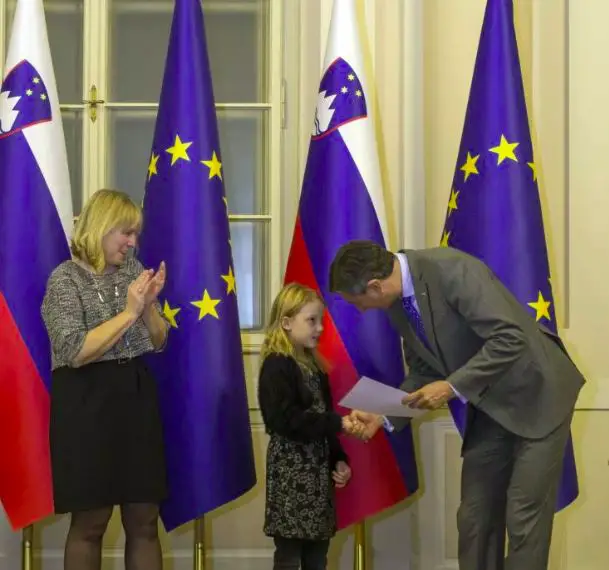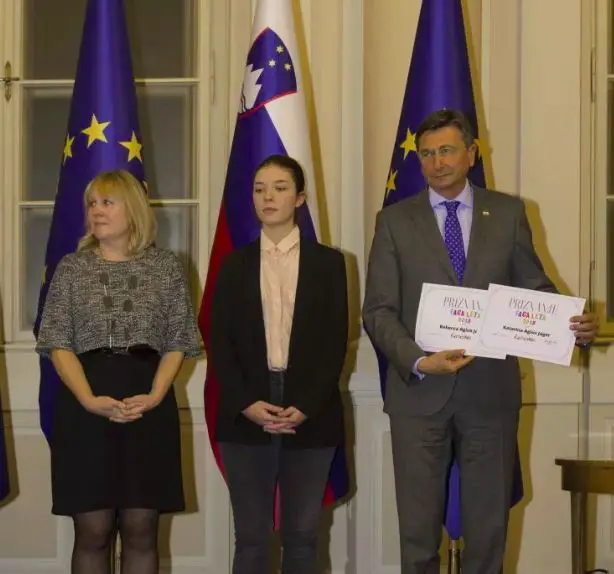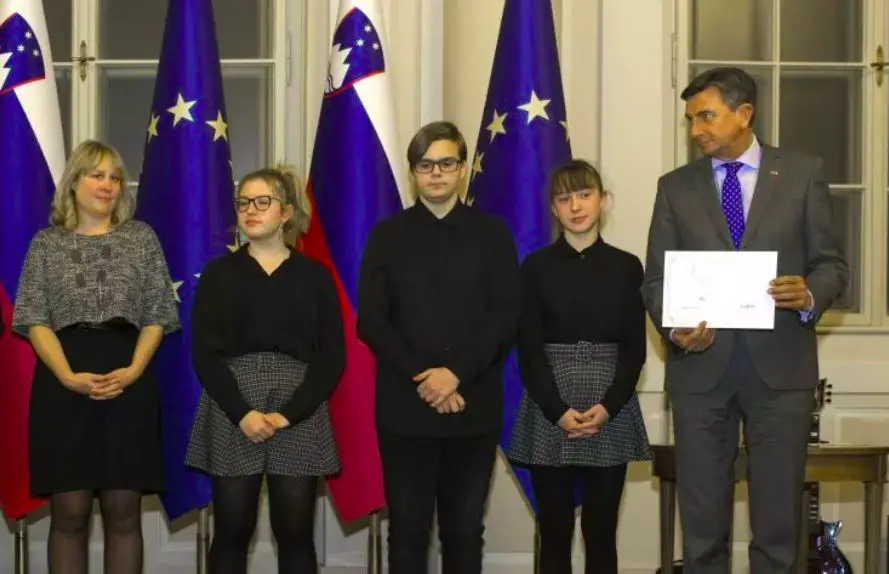Ljubljana related
Časoris is an online newspaper aimed at children. Each week we’ll take an article and post it here as a Slovene-English dual text.
Praznične luči, prižgite se!
Holiday lights, turn on!
Written by Barbara Petrovčič translated by JL Flanner & G Translate
Si že v nizkem štartu za veseli december?
Are you already in a low-key start for Happy December?
Božičnega vzdušja ni brez toplih oblačil, dišečih piškotov, božičnih pesmi, z lučkami obsijanega mesta in božične jelke.
There is no Christmas atmosphere without warm clothes, delicious smelling cookies, Christmas carols, the lights of a bright city and a Christmas tree.
V Ljubljani že nekaj dni krasijo mesto, da bi kljub pandemiji koronavirusa meščanom pričarali božično vzdušje.
In Ljubljana for several days now the city has been getting decorated to conjure up a Christmas atmosphere for people, despite the coronavirus pandemic.
Božična smreka na Prešernovem trgu že stoji. Petdeset kilometrov luči je obešenih in danes bodo prvič zasvetile.
The Christmas spruce in Prešeren Square is already standing. Fifty kilometres of lights are hanging and they will light up for the first time today.
A zaradi koronavirusa bo tradicionalen prižig lučk drugačen kot do zdaj. Nobene prireditve ne bo, tudi nagovora župana ne. Na Mestni občini Ljubljana pravijo, da bodo lučke prižgali enkrat sredi dneva in ne v popoldanskih urah kot običajno.
But because of the coronavirus, the traditional turning on of lights will be different than before. There will be no event, not even the mayor's address. The City of Ljubljana says that the lights will be turned on in the middle of the day and not in the afternoon as usual.
»Čeprav zbiranje trenutno ni dovoljeno, bo vseeno lepo. Ljubljančani si bodo okrasitev lahko ogledali na sprehodu in tako začutili malce božičnega vzdušja,« so zatrdili na občini.
“Although gathering is not allowed at the moment, it will still be nice. The people of Ljubljana will be able to see the decoration on a walk and thus feel a bit of the Christmas atmosphere, "said the municipality.
Za letošnjo okrasitev je že drugo leto zapored poskrbel Urban Modic, sin Zmaga Modica, ki je Ljubljano okraševal kar enaindvajset let. Velik del okrasitve ostaja enak kot prejšnja leta, nekaj elementov pa bo novih.
For the second year in a row, this year's decorations were taken care of by Urban Modic, the son of Zmago Modic, who has been decorating Ljubljana for twenty-one years. Much of the decorations remain the same as in previous years, but some elements will be new.
Tema letošnje okrasitve je »ranljivost in trdoživost življenja«.
The theme of this year's decorations is "the vulnerability and durability of life".
Letos so prav tako odpovedani vsi koncerti.
All concerts are also cancelled this year.
Kaj pa silvestrski ognjemet?
What about New Year's Eve fireworks?
Na občini si želijo, da bi se razmere dovolj izboljšale, da bi lahko izpeljali božični sejem in silvestrski ognjemet.
The municipality wants the situation to improve enough to be able to hold a Christmas fair and New Year's Eve fireworks.
Lučke bodo te dni prižgali tudi v drugih mestih po Sloveniji – v Mariboru, Kopru, Novem mestu, Kranju in Celju. Koronavirus pa je povsod preprečil koncerte in druge dogodke, na katerih se je prejšnja leta v prazničnem decembru trlo ljudi.
The lights will also be turned on these days in other cities in Slovenia - in Maribor, Koper, Novo mesto, Kranj and Celje. The coronavirus, however, prevented concerts and other events everywhere, which in previous years were crowded in festive December.
Read more stories and improve your Slovene at Časoris, while all our dual texts can be found here.
Časoris is an online newspaper aimed at children. Each week we’ll take an article and post it here as a Slovene-English dual text.
Ptice so začele peti tiše
The birds began to sing quieter
Written by Urša Adamič, translated by JL Flanner & G Translate
Od sredine marca, ko so povsod po svetu začeli veljati ukrepi zaradi pandemije, je raziskovalna skupina natančno poslušala oglašanje ptic na obali San Francisca in v njegovi okolici.
Since mid-March, when pandemic measures took effect around the world, a research team has been listening intently to bird calls on and around the San Francisco coast.
Prišla je do presenetljivega odkritja: ptice so prepevale tišje kot leta poprej. In ne samo to. Tudi njihovo vedenje se je spremenilo.
it made a surprising discovery: the birds sang quieter than previous years. And not only that. Their behaviour has also changed.
Poslušali so beloglave vrabonade iz družine vrabcev. Na podeželju, kjer je slišati le veter in morske valove, pojejo drugače kot v glasnem mestu.
They listened to the white-crowned sparrow from the sparrow family. In the countryside, where only the wind and sea waves can be heard, they sing differently than in a loud city.
Vozila proizvajajo stalen šum na nizki frekvenci. Slišimo ga kjerkoli v mestu. Zaradi tega mestnega šuma se tudi ptice pevke med seboj slabše slišijo.
Vehicles produce constant noise at low frequency. We hear it everywhere in the city. Due to this city noise, songbirds also hear each other less well.
»To jim povzroča veliko težav. S svojo pesmijo namreč iščejo partnerja, branijo hrano in gnezdo. Številne ptice pevke so razvile prilagoditve, s katerimi preglasijo mestni hrup,« je za Časoris razložila vodja raziskovalne skupine Elizabeth Derryberry.
“It causes them a lot of problems. With their song they’e looking for a partner, defending food and a nest. Many songbirds have developed adaptations to overcome city noise, ”research team leader Elizabeth Derryberry told Časoris.
Da bi ptice preglasile šum iz okolice, so se v mestu začele oglašati glasneje in na višjih frekvencah. V času umiritve javnega življenja zaradi pandemije novega koronavirusa pa se je mestni šum močno zmanjšal in vplival tudi na petje ptic.
In order for the birds to drown out the noise from the surroundings, they began to sing louder and at higher frequencies in the city. At a time when public life was calming down due to the novel coronavirus pandemic, however, city noise was greatly reduced and this also affected bird singing.
»Šum mesta je postal podoben šumu iz časa, ko so v njem odraščali naše babice in dedki. Ko je mesto skoraj utihnilo, se je spremenilo tudi petje ptic. Pele so tišje, na nižjih frekvencah in uporabljale so širši razpon tonov,« je še dodala Elizabeth.
“The noise of the city has become similar to the noise from the time when our grandparents grew up in it. As the city almost fell silent, the birdsong also changed. They sang quieter, at lower frequencies, and used a wider range of tones, ”added Elizabeth.
Njihov napev je postal bolj podoben napevu ptičev na podeželju. Njihovo petje je bilo slišati dvakrat dlje kot ponavadi.
Their song became more like the songs of birds in the countryside. Their singing was heard twice as long as usual.
Tudi njihovo vedenje se je spremenilo. Samci so postali manj bojeviti.
Their behaviour has also changed. Males have become less combative.
>Napev samca beloglavega vrabonada
The tune of a male white-crowned sparrow.
Read more stories and improve your Slovene at Časoris, while all our dual texts can be found here.
Časoris is an online newspaper aimed at children. Each week we’ll take an article and post it here as a Slovene-English dual text.
Ne meči hrane v smeti
Don't throw food in the trash
Written by Romana Dobnikar Šeruga translated by JL Flanner & G Translate
Na mednarodni dan ozaveščanja o izgubah hrane in odpadni hrani so mediji poročali o tem, koliko hrane vržemo v smeti, in opozarjali, kako narobe je to. Vendar en dan na leto ni dovolj! O tej temi bi morali govoriti in razmišljati vsak dan.
On International Food Loss and Food Waste Awareness Day, the media reported on how much food we throw in the trash and warned how wrong it was. But one day a year is not enough! We should talk and think about this topic every day.
Vsak Slovenec na leto zavrže kar 68 kilogramov hrane v smeti. Preračunajmo: to je 20 dekagramov ali skoraj štiri žemljice na dan. Ogromno hrane se izgubi že na poti do potrošnika, nato pa konča v smeti, skupaj z neprodano hrano iz trgovin in ostanki hrane iz gostiln, šol in družinskih miz.
Every Slovene throws as much as 68 kilograms of food a year in the trash. Let’s recalculate: that’s 20 decagrams, or almost four buns a day. A huge amount of food is lost already on the way to the consumer, it then ends up in the trash, along with unsold food from stores and leftover food from restaurant, school and family tables.
Združeni narodi so si zastavili cilj, da v desetih letih zmanjšamo količino odpadne hrane za polovico in hkrati odpravimo lakoto v svetu. Kako lahko to dosežemo?
The United Nations has set itself the goal of halving the amount of food waste in ten years while eliminating world hunger. How can we achieve this?
Viške hrane podarimo tistim, ki so še lačni. Nekateri živilski trgovci vsak večer ostanke sveže neprodane hrane predajo predstavnikom različnih človekoljubnih organizacij, da jih razdelijo tistim, ki hrane ne morejo kupiti. To je lep zgled. Toda iz trgovin pride samo deset odstotkov ostankov hrane. Najbolj potratno s hrano ravnamo v gospodinjstvih. Mi sami smo krivi za več kot polovico vse zavržene hrane, opozarja novinarka Dela Maja Prijatelj Videmšek.
We give surplus food to those who are still hungry. Some food retailers hand over leftovers of fresh unsold food to representatives of various humanitarian organisations every night to distribute to those who cannot buy food. This is a good example. But only ten percent of leftover food comes from stores. The most food waste is in households. We ourselves are to blame for more than half of all discarded food, warns Delo journalist Maja Prijatelj Videmšek.
Zato si moramo prizadevati, da kupimo in si pripravimo le toliko hrane, kolikor jo lahko pojemo. Ostanke shranimo in pojemo kasneje. Viške hrane pa lahko podarimo naprej. Zveza prijateljev mladine Slovenije vsako leto razpiše natečaj Evropa v šoli. Naslov letošnjega se glasi Če kruhek pade ti na tla, poberi in poljubi ga.
Therefore, we should strive to buy and prepare only as much food as we can eat. The leftovers are stored and eaten later. Surplus food can be donated. Every year, the Association of Friends of the Youth of Slovenia announces the Europe at School competition. This year's title is If the bread falls to the ground, pick it up and kiss it.
Read more stories and improve your Slovene at Časoris, while all our dual texts can be found here.
Časoris is an online newspaper aimed at children. Each week we’ll take an article and post it here as a Slovene-English dual text.
Zbogom, ledena plošča!
Goodbye, ice sheet!
Written by Romana Dobnikar Šeruga, translated by JL Flanner & G Translate
Še zadnja nedotaknjena ledena plošča na kanadskem severu je izgubila skoraj polovico svoje površine in se zrušila v morje.
The last untouched ice sheet in the Canadian north lost almost half of its surface and crashed into the sea.
»Nadpovprečne temperature zraka, vetrovi blizu obale in učinki odprtega morja so recept za odlom ledene plošče,« je dogodek na Twitterju komentirala kanadska služba za spremljanje stanja ledu (Canadian Ice Service).
"Above-average air temperatures, winds near the coast and the effects of the open sea are the recipe for breaking the ice sheet," the Canadian Ice Service commented on the event on Twitter.
Satellite animation, from July 30 to August 4, shows the collapse of the last fully intact #iceshelf in #Canada. The Milne Ice Shelf, located on #EllesmereIsland in #Nunavut, has now reduced in area by ~43%. #MilneIceIsland #seaice #Arctic #earthrightnow #glacier pic.twitter.com/jjs1gawoxA
— ECCC Canadian Ice Service (@ECCC_CIS) August 4, 2020
Novica žal ni nepričakovana. Arktiko, območje med severnim tečajem in severnim tečajnikom, je tudi to poletje zajel vročinski val in po njej pustošijo številni gozdni požari. V sibirskem mestu Verhojansk so leta 1892 namerili najnižjo temperaturo na severni polobli, minus 68 stopinj Celzija. 20. junija letos pa so v do zdaj najhladnejšem naseljenem kraju na svetu zabeležili rekordno temperaturo: 38 stopinj Celzija. To je kar 18 stopinj več, kot je najvišja povprečna junijska dnevna temperatura.
Unfortunately, the news is not unexpected. The Arctic, the area between the North Pole and the North Circle, has also been hit by a heatwave this summer and is ravaged by numerous forest fires. In the Siberian city of Verkhoyansk, the lowest temperature in the northern hemisphere, -68° Celsius, was measured in 1892. On June 20 this year, a record temperature was recorded in the coldest inhabited place in the world so far: 38° Celsius. That’s as much as 18 degrees more than the highest average June daily temperature.
Julija je bilo arktičnega morskega ledu najmanj v zadnjih 40 letih. Območje večnega ledu se zadnjih 30 let segreva dvakrat hitreje od globalnega povprečja. Naraščajoče temperature talijo arktični morski led. Odprta voda, ki pri tem nastane, pa vpije še več sončnih žarkov, kar še bolj ogreje Arktiko. In začaran krog je sklenjen.
In July there was the smallest amount of Artic sea ice for the last 40 years. The permafrost has been warming twice as fast as the global average for the past 30 years. Rising temperatures are melting Arctic sea ice. The resulting open water absorbs even more sunlight, further warming the Arctic. And the vicious cycle is closed.
A ne talijo se samo mogočne ledene plošče in ledeniki, topi se permafrost, trajno zamrznjena tla, v katerih se skrivajo tudi do sto tisoč let stari virusi in bakterije. Kaj bi se zgodilo, če bi se odmrznili povzročitelji kakšnih starih nalezljivih bolezni? Temu problemu v času pandemije novega koronavirusa znanstveniki namenjajo veliko pozornosti.
But it's not just mighty ice sheets and glaciers that are melting, permafrost is melting – permanently frozen soils that contain viruses and bacteria that are up to a hundred thousand years old. What would happen if the causes of some old infectious diseases thawed? Scientists are paying close attention to this problem during the new coronavirus pandemic.
»Bakterije lahko preživijo dolgo časa, to je v znanstvenih krogih sprejeto dejstvo. Vprašanje je le, kako dolgo. Milijon let? Petsto tisoč let? Petdeset tisoč let?« se za Unearthed sprašuje virolog Jean Michel Claverie.
“Bacteria can survive for a long time, this is a fact accepted in scientific circles. The question is just how long. A million years? Five hundred thousand years? Fifty thousand years? ”Asks virologist Jean Michel Claverie for Unearthed.
Če bo šlo tako naprej, na Arktiki leta 2050 ne bo več ledu.
If it goes on like this, there will be no more ice in the Arctic in 2050.
Read more stories and improve your Slovene at Časoris, while all our dual texts can be found here.
Časoris is an online newspaper aimed at children. Each week we’ll take an article and post it here as a Slovene-English dual text.
TikTok bo morda res ukinjen, a če že, za zdaj le v ZDA
TikTok may really be banned, but if so, for now only in the US
Written by Sonja Merljak Zdovc, translated by JL Flanner & G Translate
Med tiktokerji se je razširila novica, da bodo priljubljeno družbeno omrežje TikTok kar ukinili. Menda naj bi to zahteval predsednik Združenih držav Amerike Donald Trump.
News spread among tiktokers that the popular social network TikTok will be banned. Presumably, this was demanded by the President of the United States of America, Donald Trump.
Te je zaskrbelo, da ne boš več mogla spremljati priljubljenih tiktokerjev?
Worried that you won't be able to follow your favorite tiktokers anymore?
Brez skrbi. Donald Trump lahko vpliva le na dogajanje v Združenih državah Amerike.
No worries. Donald Trump can only influence what is happening in the United States.
Trump razmišlja, da bi TikTok ukinil, ker trdi, da ta ogroža nacionalno varnost, saj je TikTok v lasti kitajskega podjetja. Kitajska vlada naj bi tako imela dostop do številnih podatkov uporabnikov TikToka.
Trump is considering banning TikTok because he claims it threatens national security, as TikTok is owned by a Chinese company. The Chinese government is thus said to have access to the data from TikTok users.
Strokovnjaki pravijo, da ni čisto tako, je pa res, da so imeli v podjetju ByteDance težave z varovanjem podatkov in z varnostjo na spletu.
Experts say that's not quite the case, but it's true that ByteDance had problems with data protection and online security.
Res je tudi, da aplikacija zbira veliko podatkov. A tudi druga družbena omrežja zbirajo veliko podatkov, čeprav manj kot TikTok. In znano je, da tuje države zlorabljajo tudi Facebook in Twitter.
It’s also true that the app collects a lot of data. But other social networks also collect a lot of data, although less than TikTok. And it’s also known that foreign countries abuse Facebook and Twitter.
Kljub temu pa velja biti na nekaj stvari pozoren, če uporabljaš aplikacijo. Na TikToku se obnašaj, kot se v resničnem življenju.
However, there are a few things to keep in mind when using the app. On TikTok, behave like you do in real life.
Preveri nastavitve zasebnosti, denimo glede lokacije in dovoljenja za dostop do različnih osebnih podatkov.
Check your privacy settings, such as location and permission to access various personal information.
Ne verjemi vsemu, kar vidiš, in novice raje preveri v verodostojnih medijih za otroke, ki jim lahko zaupaš, denimo v Časorisu.
Don’t believe everything you see, and rather check the news in credible media for kids you can trust, like in Časoris.
Če o nečem nismo pisali, to morda pomeni, da ni res ali da se ni zgodilo.
If we haven’t written about something, it may mean it’s not true or that it didn’t happen.
Lahko se zgodi, da kakšno novico spregledamo. V takem primeru nas opozori na to, še posebej, če te zanima kaj več o tej novici ali če imaš kakšno vprašanje, ki je povezano z njo. Nam lahko svoje vprašanje pošlješ na This email address is being protected from spambots. You need JavaScript enabled to view it. in poskusili bomo poiskati odgovor nanj.
We may overlook some news. In such a case, let us know, especially if you are interested in more about this news or if you have any questions related to it. In such a case, you can send your question to This email address is being protected from spambots. You need JavaScript enabled to view it. and we will try to find the answer.
Read more stories and improve your Slovene at Časoris, while all our dual texts can be found here.
Časoris is an online newspaper aimed at children. Each week we’ll take an article and post it here as a Slovene-English dual text.
Se bojiš ognjenih črvov?
Are you scared of fireworms?
Written by Urša Adamič, translated by JL Flanner & G Translate
Medije v poletnih dneh pogosto preplavljajo novice o nevarnih živalih, ki prebivajo v morju.
The media during summer days is often flooded with news about dangerous animals living in the sea.
Bolj ko je novica zastrašujoča in dramatična, hitreje se širi. V naslovih novinarskih prispevkov se zato rade šopirijo besede, ki ljudi prestrašijo. A običajno so pretirane in celo neresnične.
The more frightening and dramatic the news, the faster it spreads. In the headlines of journalists’ articles, therefore, they like to show off words that frighten people. But they are often exaggerated and even untrue.
Te je že srečala novica o invaziji ognjenih črvov, ki na kopalce prežijo v Jadranskem morju? O njih so pisali že lani, ko naj bi eden napadel plavalko, ki je nato potrebovala zdravniško pomoč.
Have you encountered the news about the invasion of fireworms that prey on bathers in the Adriatic Sea? They were written last year when one allegedly attacked a swimmer who then needed medical attention.
Ob natančnem branju in raziskovanju te vrste postane jasno, da ognjeni črvi ne napadajo ljudi. Res pa je, da ni prijetno, če nanje stopimo ali se jih kako drugače dotaknemo.
Upon careful reading and research on this species, it becomes clear that fireworms do not attack humans. It is true, however, that it is not pleasant to step on them or touch them in any other way.
Ognjeni črvi spadajo med mnogoščetince. Ta skupina večinoma morskih živali je ime dobila po številnih ščetinah, ki izraščajo iz njihovega telesa. Premikajo se počasi, veliki so okoli 15 centimetrov in so pod vodo zaradi svoje rdeče barve dobro vidni.
Fire worms are among the polychaetes. This group of mostly marine animals is named after the many bristles that grow out of their bodies. They move slowly, are about 15 centimeters in size and are clearly visible underwater due to their red color.
Prehranjujejo se z drugimi organizmi in rastlinami na morskem dnu, med drugim jedo tudi morske zvezde. Če se počutijo ogrožene, napnejo svoje bele ščetine, ki vsebujejo strup.
They feed on other organisms and plants on the seabed, including starfish. If they feel threatened, they push out their white bristles, which contain poison.
Ščetine lahko predrejo kožo in povzročijo srbečico in pekoč občutek na mestu vboda. Takrat je priporočljivo, da iglice odstranimo z lepljivim trakom in mesto vboda spiramo s hladno morsko vodo. Nato si namestimo v alkohol pomočene obkladke in namažemo s protivnetno kremo.
The bristles can penetrate the skin and cause itching and a burning sensation at the injection site. At that time, it is recommended to remove the needles with adhesive tape and rinse the injection site with cold sea water. Then place compresses soaked in alcohol and apply anti-inflammatory cream.
V nekaterih primerih lahko začutimo tudi slabost in vrtoglavico. Če se po nekaj urah še vedno slabo počutimo, strokovnjaki priporočajo obisk zdravnika.
In some cases, nausea and dizziness may also be felt. If we still feel unwell after a few hours, experts recommend a visit to the doctor.
Read more stories and improve your Slovene at Časoris, while all our dual texts can be found here.
Časoris is an online newspaper aimed at children. Each week we’ll take an article and post it here as a Slovene-English dual text.
Virusi v tebi
Viruses in you
Written by Urša Adamič, translated by JL Flanner & G Translate
Raziskovalci nevidnega sveta mikroorganizmov človeško telo vedno bolj razumejo kot ekosistem različnih organizmov.
Researchers of the invisible world of microorganisms increasingly understand the human body as an ecosystem of various organisms.
Kot recimo v gozdu domujejo različne vrste živali in rastlin, je tudi naše telo dom različnih bakterij in virusov.
Just as a forest is home to different species of animals and plants, our body is also home to various bacteria and viruses.
Raziskovalci najbolj poznajo bakterije v črevesju. Vedno več pozornosti posvečajo tudi virusom. Po zadnjih ocenah jih je v našem telesu veliko več kot bakterij. Velike večine jih sploh še ne poznamo, saj so ti tako zelo različni.
Researchers know the bacteria in the gut best. They are also paying more and more attention to viruses. According to the latest estimates, there are many more of them in our body than bacteria. We don't even know the vast majority of them yet, because they are so very different.
Celoten nabor virusov imenujemo virom. Od človeka do človeka se ta virom zelo razlikuje, pa tudi ljudje iz različnih delov sveta imajo zelo različne virome zaradi različnih prehranjevalnih in higienskih navad.
The whole set of viruses is called a virome. This virome varies greatly from person to person, and people from different parts of the world also have very different viromes due to different eating and hygiene habits.
Znanstveniki so izolirali različne ostanke virusnih genov iz blata dvojčkov in njune matere. Ugotovili so, da so bili njihovi virusi zelo različni virusi, pa tudi, da imajo zdravi ljudje v telesu ogromno virusov.
Scientists have isolated various remnants of viral genes from the faeces of the twins and their mother. They found that their viruses were very different viruses, and also that healthy people have a huge amount of viruses in their bodies.
Številni virusi nam pomagajo pri prebavi hrane. V debelem črevesju recimo bakteriofagi – virusi bakterij – uravnavajo številčnost bakterij. Tako varujejo naše telo pred okužbo.
Many viruses help us digest food. In the large intestine, for example, bacteriophages – bacterial viruses – regulate the amount of bacteria. This protects our body from infection.
Virusi ne živijo le v debelem črevesju. Svojo sled so pustili tudi na naših genih. Pred 25 milijoni let se je v genom višjih primatov vrinil retro virus.
Viruses don’t just live in the colon. They also left their mark on our genes. Twenty-five million years ago, a retrovirus entered the genome of higher primates.
Ta je povzročil razvoj novega organa pri samicah. Med nosečnostjo se od tedaj v maternici razvije placenta, ki omogoča preskrbo zarodka s hrano.
This led to the development of a new organ in females. During pregnancy, the placenta develops in the uterus, which allows the fetus to be supplied with food
Nova lastnost je zmanjšala smrtnost zarodkov in za vrsto predstavljala tako veliko prednost, da se je virus v našem genomu ohranil do danes.
This new trait reduced embryo mortality and was such a huge advantage for the species that the virus has survived in our genome to this day.
Read more stories and improve your Slovene at Časoris, while all our dual texts can be found here.
Časoris is an online newspaper aimed at children. Each week we’ll take an article and post it here as a Slovene-English dual text.
Otroci so v šoli tudi na varnem, na toplem, niso lačni in niso žejni
Children are also safe, warm, not hungry and thirsty at school
Written by Sonja Merljak Zdovc, translated by JL Flanner & G Translate
Da igra šola v življenju otrok zelo pomembno vlogo, nam je zdaj bolj jasno kot kdajkoli prej.
It is now more clear than ever that school plays a very important role in children's lives.
Poleg osnovne vloge, izobraževanja, ima še številne druge, pravi klinična psihologinja dr. Mateja Hudoklin iz Svetovalnega centra za otroke, mladostnike in starše.
Besides the basic role, education, there are many others, says clinical psychologist Dr. Mateja Hudoklin from the Counselling Center for Children, Adolescents and Parents.
V šoli se otroci družijo, navezujejo stike z vrstniki in odraslimi, se urijo v socialnih veščinah, učijo se uravnavati svoje vedenjske in čustvene odzive.
At school, children socialise, interact with peers and adults, learn social skills, learn to regulate their behavioural and emotional responses.
Ali je to enako pomembno za vse otroke?
Is this equally important for all children?
Marsikdaj zadovoljuje tudi tiste potrebe, ki bi jih moralo zadovoljevati ožje otrokovo okolje.
Many times it also meets the needs that should be satisfied by the child's environment.
Otroci so v šoli na varnem, na toplem, niso lačni in niso žejni. Šolsko življenje nudi strukturo, z vsemi pravili in odnosi in vse to otrokom daje občutek varnosti. Večina otrok v šoli najde prijatelje, simpatije, tudi odrasle vzornike.
Kids are safe, warm, not hungry or thirsty at school. School life offers a structure, with all the rules and attitudes, and it gives children a sense of security. Most children find friends, warmth, even adult role models at school.
Mnogi otroci vsega tega ne dobijo v družinskem okolju.
Many children do not get all this in a family setting.
Kako pa to, da ni šole, vpliva na otroke?
How does being out of school affect children?
Prve tedne je bilo ostajanje doma verjetno za večino otrok prijetno, mnogi so jih doživljali kot male počitnice.
For the first few weeks, staying home was probably enjoyable for most children, many experiencing it as a small vacation.
Sčasoma se ti občutki spreminjajo. Vedno bolj pogrešajo stike z vrstniki, aktivnosti.
Over time, these feelings change. They are increasingly missing peer contacts, activities.
Mnogi otroci težko samostojno delajo za šolo in potrebujejo pomoč staršev. To je lahko vir dodatnih napetosti doma. Mnoge tudi skrbi, kako bo z ocenami.
Many children find it difficult to work independently for school and need the help of their parents. This can be a source of additional tension at home. Many also worry about how the grades will be.
Negotovost povečuje zaskrbljenost in občutek tesnobe. Zdaj toliko bolj prihaja v ospredje, v kakšni družini in okolju živi otrok.
Uncertainty increases fear and anxiety. Now the family and environment a child lives in come to the fore.
Read more stories and improve your Slovene at Časoris, while all our dual texts can be found here.
Časoris is an online newspaper aimed at children. Each week we’ll take an article and post it here as a Slovene-English dual text.
Zakaj so medvedi po prespani zimi še vedno fit?
Why are bears still fit after a sleepy winter?
Written by Urša Adamič, translated by JL Flanner & G Translate
Predstavljajte si, da bi celo zimo prespali.
Imagine sleeping all winter long.
Mišice bi izgubile svojo moč, na koži bi se pojavile odrgnine in verjetno bi bili sestradani. No, grizliji s tem nimajo težav.
[Your] muscles would lose their strength, there would be bruises on the skin and you’d probably be starving. Well, grizzlies have no problem with all that.
Grizli je podvrsta rjavega medveda, ki živi v Severni Ameriki. V nedavno objavljeni raziskavi so znanstveniki razkrili, kaj grizlijem pomaga, da ohranijo mišice tudi po prespani zimi.
Grizzlies are a subspecies of brown bear living in North America. In a recent study, scientists revealed what helps grizzlies retain their muscles after a sleepy winter.
V času zimskega spanja oziroma hibernacije medvedi izgubijo skoraj tretjino telesne mase.
During the winter sleep, or hibernation, bears lose almost a third of their body weight.
Zaradi upočasnjenega dihanja in srčnega utripa se upočasnita tudi prebava in nastajanje urina. Med zimskim spanjem medvedi kar nekaj mesecev ne izločajo urina in blata, zato pa se v njihovem telesu kopiči dušik.
Due to slow breathing and heart rate, digestion and urine production are also slowed down. During the winter sleep, bears do not excrete urine and faeces for several months, which is why nitrogen builds up in their bodies.
Dušik je ključna sestavina aminokislin, iz katerih so zgrajeni proteini, iz njih pa so sestavljene mišice.
Nitrogen is a key component of the amino acids that proteins are made of, which muscle is made of.
Znanstveniki so ugotovili, da medvedi med zimskim spanjem dušika ne izločijo iz telesa z urinom, pač pa se ta vgradi nazaj v mišice in tako prepreči njihovo razgradnjo.
Scientists have found that bears do not excrete nitrogen from the body during the winter sleep with urine, but that it goes back into the muscles to prevent their breakdown.
Izguba mišične mase je problematična pri ljudeh, ki zaradi bolezni dolgo časa ležijo.
Muscle loss is problematic for people who are lying down for a long time due to illness.
Tudi pri astronavtih, ki mišic v breztežnostnem prostoru v vesolju ne morejo uporabljati, se te postopoma začnejo razgrajevati.
Also in astronauts who are unable to use their muscles in the weightlessness of space they gradually begin to break down.
S poznavanjem mehanizma ohranjanja mišične mase bi lahko olajšali tako življenje v vesolju kot tudi na Zemlji.
Knowing the mechanism of preserving muscle mass could make life easier in space as well as on Earth.
Slovar / Dictionary
Proteini (oziroma beljakovine) so sestavljeni iz aminokislin in imajo v telesu zelo različne vloge, med drugim so pomembni tudi pri izgradnji mišic.
Proteins (or proteins) are made up of amino acids and play very different roles in the body, including being important in muscle building.
Aminokisline so molekule iz dušika, vodika, kisika in ogljika, ki predstavljajo osnovno gradbeno enoto proteinov.
Amino acids are molecules of nitrogen, hydrogen, oxygen and carbon, which are the basic building blocks of proteins.
Dušik je kemijski element, ki se nahaja v ozračju in je pomemben gradnik v vseh živih bitjih. Iz telesa ga izločamo s sečnino oziroma urinom.
Nitrogen is a chemical element that is found in the atmosphere and is an important building block in all living things. It is excreted in the body with urea or urine.
Read more stories and improve your Slovene at Časoris, while all our dual texts can be found here.
Slovene-English Dual Text: Faca leta 2019: Pogumni Otroci, Ki Si Drznejo Sanjati
Časoris is an online newspaper aimed at children. Each week we’ll take an article and post it here as a Slovene-English dual text.
Faca leta 2019: pogumni otroci, ki si drznejo sanjati
"Cool Kids" of 2019: brave children who dare to dream
Written by Sonja Merljak Zdovc, translated by JL Flanner & G Translate
Bil je smeh, bile so solze, bila je glasba, bile so besede.
There was laughter, there were tears, there was music, there were words.
V Predsedniški palači smo veliko lepega povedali in veliko lepega slišali. Kaj ne bi, če pa smo podeljevali priznanja faca leta 2019!
We said a lot of good things in the Presidential Palace and heard a lot of good things. And why shoudn’t we, we had been awarded Cool Kids of the Year 2019!
V Časorisu smo lani s priznanjem faca leta prvič počastili otroke, ki spreminjajo svet okoli sebe.
At Časoris last year, with the recognition of the Cool Kids of the Year, we first honoured children who are changing the world around them.
Letos smo znova vse leto izbirali Cool Kid meseca, da smo jih potem povabili na slovesno prireditev in podelitev priznanj.
This year, we again selected all the Cool Kids of the Month from all year, then invited them to an event ceremony with an awards ceremony.
Cool Kid leta 2019 so otroci, ki izstopajo, ki imajo poseben talent, ki so navdih mladim, pa tudi starejšim, kot je povedala voditeljica prireditve, osmošolka Taja Zidanšek. Med njimi so tako umetniki kot raziskovalci, znanstveniki in misleci, poslovneži in dobrodelneži.
The Cool Kids of the Year 2019 are outstanding children who have a special talent that inspires young people, as well as older ones, according to the event's host, eighth-grader Taja Zidanšek. These include artists as well as researchers, scientists and thinkers, businessmen and philanthropists.
In kdo so dobitniki priznanj faca leta 2019?
And who are the recipients of the 2019 Cool Kids of the Year awards?
Faca januarja je Simon Štiblar. Skromen fant iz Prekmurja kljub svojim posebnim potrebam ali prav zaradi njih rad navezuje stike prek družbenih omrežij. S svojo prisotnostjo na omrežjih in v medijih pomaga drugim sprejemati in razumeti osebe z avtizmom. Srečo vidi v malenkostih, ki jih drugi hitro spregledajo. Vesel je že, denimo, kadar mu poštar prinese novo majico, skodelico ali vsaj račune, s katerimi lahko sodeluje v nagradni igri.
The Cool Kid of January is Simon Stiblar. A modest guy from Prekmurje, despite his special needs or because of them, he likes to connect through social networks. Through its presence on networks and in the media, it helps others accept and understand people with autism. He sees happiness in little things that are quickly overlooked by others. He is happy, for example, when a postman brings him a new T-shirt, cup or at even coups so he can participate in prize draws.
Faca februarja je Kristjan Veber. Ko opazi stisko drugih, vedno ponudi svojo pomoč. Že kot dijak Gimnazije Celje – Center je pripravil številne dobrodelne dogodke. Samo letos je, ker smo ravno leta 2019 in ker je sam star 19 let, pripravil 19 različnih dobrodelnih akcij.
The Cool Kid of February is Kristjan Veber. When he notices the distress of others, he always offers his help. Already as a student at Celje High School – Center, he has organised numerous charity events. This year alone, because we are in 2019 and he is 19 years old, he put together 19 different charity campaigns.
Faca marca je Andrei Morozov. S programiranjem je pri 13 letih zaslužil prvih 120 evrov, sedaj pa izumlja nove koristne pripomočke. Med drugim je razvil elektronsko kresničko, ki varuje otroke v prometu. Svojo poslovno idejo je predstavil tudi kot eden od desetih štipendistov Fundacije za ustvarjalne mlade, kjer so iskali najboljšo globalno odgovorno idejo in najuspešnejši mladinski startup.
The Cool Kid of March is Andrei Morozov. With programming, he earned his first €120 at the age of 13 and is now inventing new, useful gadgets. Among other things, he developed an electronic helper [lit. “godfather”] that protects children in traffic. He also presented his business idea as one of the ten Creative Youth Foundation scholarships, looking for the best globally responsible idea and the most successful youth start-up.
Faca aprila je Kaja Miglič Pirkmaier. Navdušena ljubiteljica filma je sooblikovala letošnji 4. mednarodni filmski festival Kinotrip – mladi za mlade. To je festival, ki ga oblikujejo mladi in se dotika tem mladostništva. S ponosom lahko rečemo, da to ni le filmski festival, ampak delo, ovito v nešteto lepih spominov in doživetij, je po festivalu dejala Kaja.
The Cool Kid of April is Kaja Miglic Pirkmaier. An avid film lover, she co-organised this year's 4th International Kinotrip Film Festival - Youth for Young People. It is a festival organised by young people and touches upon the themes of youth. We can proudly say that this is not just a film festival, but a work wrapped in countless fond memories and experiences, Kaja said after the festival.
Faci maja sta Mihela Božič in Jerneja Trošt. Skupaj z drugimi učenci in učenkami osnovne šole Draga Bajta iz Vipave sta raziskovali, kako so nekoč na Primorskem preživljali počitnice. S trudom in požrtvovalnostjo jim je uspelo raziskovalno delo, ki odkriva del bogatega in pestrega življenja staršev in starih staršev. Ugotovitve sta v imenu vseh sodelujočih predstavili na srečanju mladih zgodovinarjev Slovenije.
The Cool Kids of May are Mihela Božič and Jerneja Trošt. Together with other students from the elementary school Draga Bajta from Vipava, they explored how they used to spend their holidays in Primorska. Through hard work and dedication, they have succeeded in research work that reveals some of the rich and diverse lives of parents and grandparents. The findings were presented on behalf of all participants at a meeting of young historians of Slovenia.
Faca junija je Simon Trussevich. Na svoji osnovni šoli je uspešno izpeljal dvoletni projekt Demokracija v šoli. Pod okriljem projekta so mladi izpostavili nekatere pomanjkljivosti trenutnega izobraževalnega sistema na državni in lokalni ravni, znotraj šole pa jim je marsikaj uspelo tudi popraviti in izboljšati.
The Cool Kid of June is Simon Trussevich. At his elementary school he successfully completed a two-year Democracy at School project. With the support of the project, young people highlighted some of the shortcomings of the current education system at the state and local levels, and many have managed to correct and improve a lot of these within their schools.
Cool Kid julija in avgusta so Rock Ivančki. Mladi pevci in pevke so najprej naredili čisto svoj komad, ga vsi skupaj zarockali na velikem odru, nato pa v prvih poletnih dneh posneli še videospot Rockajmo za naš planet. Sedaj rockajo na različnih prireditvah po vsej Sloveniji in svoja sporočila o prijaznosti in miru ter o skrbi za okolje učinkovito širijo skozi glasbo.
The Cool Kids of July and August are Rock Ivančic. The young singers [male and female] first made their own group, all together on the big stage, and then in the early summer days they recorded a video for We Rock for our Planet. Now they are rocking at various events across Slovenia and are effectively communicating their messages of kindness, peace and concern for the environment through music.
Faca septembra je Manica Kužner. Ker so volkovi njena najljubša žival, je njihovo življenje najprej raziskovala v raziskovalni nalogi. Poleti, ko se je v Sloveniji veliko razpravljalo o nevarnosti, ki zaradi volkov preti ljudem, se je pogumno pridružila skupini, ki spremlja število volkov, tako da izzovejo njihovo tuljenje, saj je želela te skrivnostne živali še bolje spoznati.
The Cool Kid of September is Manica Kužner. Because wolves are her favourite animal, she first explored their life in a research assignment. In the summer, when there was much discussion in Slovenia about the danger of wolves threatening people, she bravely joined a group that monitors the number of wolves by provoking their howling, as she wanted to get to know these mysterious animals even better.
Faci oktobra sta sestri Katarina in Rebecca Agius Jager. Šolali sta se v Sloveniji, v Združenih državah Amerike, trenutno pa sta v Moskvi. Povsod sta opazili, da so številni njuni vrstniki v duševni stiski. Da bi pomagali blažiti njihovo stisko oziroma da bi jih spodbudili, naj poiščejo pomoč, ki jo včasih nujno potrebujejo, sta se pridružili akciji Svetovne zdravstvene organizacije ob svetovnem dnevu duševnih bolezni, letos namenjeni preventivi pred samomori, in izvedli akcijo #40sekund.
The Cool Kids of in October are sisters Katarina and Rebecca Agius Jager. They have studied in Slovenia, in the United States, and are currently in Moscow. Everywhere, they noticed that many of their peers were mentally distressed. In order to help alleviate their distress, or to encourage them to seek the help they sometimes desperately need, they joined the World Health Organization’s action on World Mental Illness Day, this year aimed at preventing suicide year, and launched the #40second campaign.
Cool Kid novembra so Adriana Golub, Samo Medic in Mina Ravbar. Trije prijatelji, ki se poznajo že iz vrtca, so se kot čisti začetniki v debatiranju, pisanju esejev in reševanju zanimivih nalog v angleščini najprej uvrstili na regionalno tekmovanje v svetovnem pokalu znanja na Nizozemskem in tam bili tako uspešni, da so nato odpotovali še na turnir šampionov na univerzo Yale v Ameriki. Pri tem velja dodati, da svetovni pokal v znanju ni običajno tekmovanje, ampak je hvalnica učenju, saj spodbuja sodelovanje, interdisciplinarno razmišljanje in motivira sodelujoče, da v sebi najdejo talente, za katere še niso vedeli.
The Cool Kids of November are Adriana Golub, Samo Medic and Mina Ravbar. Three friends who have known each other from kindergarten, as total beginners at debating, writing essays and solving interesting tasks in English, first entered the regional competition in the World Cup in the Netherlands and were so successful there that they then went on to the tournament championships at Yale University in America. It is worth noting that the World Scholar Cup is not just a competition but an award for learning, as it encourages collaboration, interdisciplinary thinking and motivates participants to find talents they did not know about.
Vsem dobitnikom priznanja iskreno čestitamo!
Congratulations to all the winners!
Aja, kaj pa faca decembra?
Aye, what about the Cool Kid of December?
Ker meseca še ni konec, jo bomo iskali in razglasili šele januarja. Že zdaj vse bralke in bralce ter vse, ki poznate navdihujoče otroke, prijazno vabimo, da nam pošljete svoje predloge.
Since the month is not over, we will only look for it and declare it in January. Even now, all readers [male and female], and all of you who know inspirational children, are kindly invited to send us your suggestions [to This email address is being protected from spambots. You need JavaScript enabled to view it.].
Iskanje fac se nadaljuje tudi v letu 2020. Če poznaš otroka, ki navdihuje, nam piši, in z veseljem ga bomo predstavili – morda bo prav on prejemnik priznanja faca leta 2020!
The search for Cool Kids continues in 2020. If you know an inspiring child, write to us and we will be pleased to introduce them - they may be the recipient of a Cool Kids of the Year Award in 2020!
Read more stories and improve your Slovene at Časoris, while all our dual texts can be found here.


